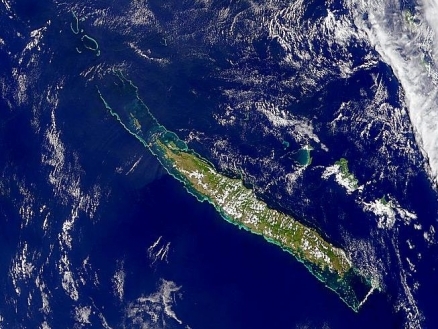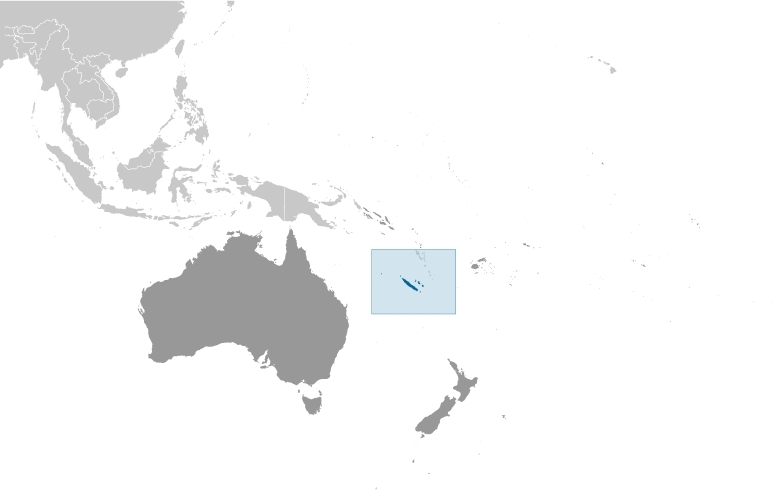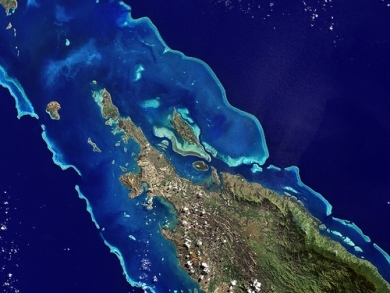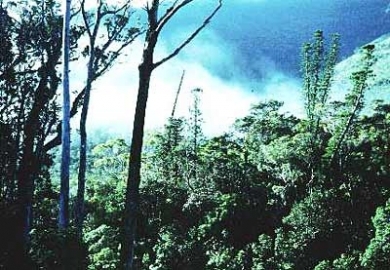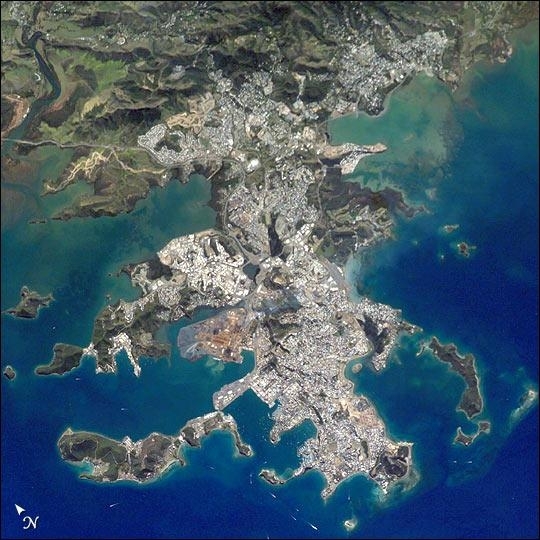New Caladonia
Contents
New Caledonia
| Topics: |
Countries and Regions of the World Collection  New Caledonia is a group of islands with a quarter of a million people in the South Pacific Ocean (the Coral Sea), east of Australia. This territory of France consists of the main island of New Caledonia (Grande Terre - one of the largest islands in the Pacific Ocean), the archipelago of Iles Loyaute (Loyalty Islands), and numerous small, sparsely populated islands and atolls.
New Caledonia is a group of islands with a quarter of a million people in the South Pacific Ocean (the Coral Sea), east of Australia. This territory of France consists of the main island of New Caledonia (Grande Terre - one of the largest islands in the Pacific Ocean), the archipelago of Iles Loyaute (Loyalty Islands), and numerous small, sparsely populated islands and atolls.
The main island of Grande Terre runs in a north-south orientation and is 16,372 square kilometers (km2).
Its major environmental issues include erosion caused by mining exploitation and forest fires.
Settled by both Britain and France during the first half of the 19th century, the island was made a French possession in 1853.
It served as a penal colony for four decades after 1864. 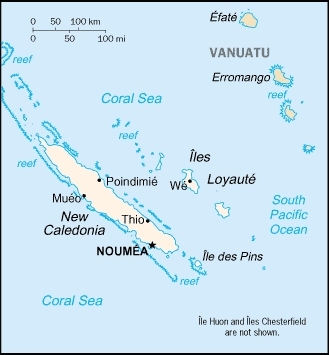
Agitation for independence during the 1980s and early 1990s ended in the 1998 Noumea Accord, which over a period of 15 to 20 years will transfer an increasing amount of governing responsibility from France to New Caledonia.
The agreement also commits France to conduct a referendum between 2014 and 2019 to decide whether New Caledonia should assume full sovereignty and independence.
Matthew and Hunter Islands east of New Caledonia claimed by France and Vanuatu.
Geography
Location: Oceania, islands in the South Pacific Ocean, about 1200 kilometres (km) east of Australia and 1500 km northeast of New Zealand..
Geographic Coordinates: 21 30 S, 165 30 E
Area: 18,575 sq km (land: 18,275 sq km; water: 300 sq km)
Coastline: 2,254 km
Maritime Claims:
Natural Hazards: cyclones, most frequent from November to March; and volcanism (Matthew and Hunter Islands are historically active).
Terrain: coastal plains with interior mountains. The highest point is Mont Panie (1,628 m).
Climate: tropical; modified by southeast trade winds; hot, humid
Ecology and Biodiversity
New Caledonia rainforests
The tropical moist New Caledonia rainforests ecoregion is generally subdivided into lowland rainforests of the Loyalty Islands and Grand Terre:
|
In July 2008, the United Nations Educational, Scientific, and Cultural Organization (UNESCO) added 27 new areas to its list of World Heritage sites. One of those areas included the lagoons of New Caledonia. Some 1,200 kilometers (750 miles) east of Australia, this French-governed archipelago contains the world’s third-largest coral reef structure. The coral reefs enclose the waters near the islands in shallow lagoons of impressive biodiversity. On May 10, 2001, the Enhanced Thematic Mapper Plus on NASA’s Landsat 7 satellite captured this image of Île Balabio, off the northern tip of Grande Terra, New Caledonia’s main island. In this natural-color image, the islands appear in shades of green and brown—mixtures of vegetation and bare ground. The surrounding waters range in color from pale aquamarine to deep blue, and the color differences result from varying depths. Over coral reef ridges and sand bars, the water is shallowest and palest in color. Darker shades of blue characterize deeper waters. Reef-enclosed, shallow waters surround Île Balabio, and a larger, semi-enclosed lagoon appears immediately east of that island. Immediately north of Grande Terra, unenclosed, deeper waters predominate. The coral reefs around New Caledonia support an unusual diversity of species, including large numbers of predators and big fish, turtles, and the world’s third-largest dugong population. NASA image created by Jesse Allen, using Landsat data provided by the United States Geological Survey. Caption by Michon Scott. |
| Riviere Bleue Reserve, New Caledonia. Photograph by David Olson |
- the montane forests of Grand Terre; and,
- Grand Terre's wet maquis forest.
The lowland tropical rainforests are of a mixed-species composition, with the prevalent gymnosperms being Agathis lanceolata, A. ovata, Araucaria columnaris, A. bernieri, Dacrydium araucarioides, Dacrycarpus vieillardii, and Falcatifolium taxoides.
Montane rain forest species include Araucaria, Agathis, Podocarpus, Dacrydium, Libocedrus, Acmopyle, Metrosideros, Weinmannia, Quintinia, and Nothofagus.
The unique maquis forests on Grande Terre are dominated by Araucaria species. Their scrublike structure resembles that of Mediterranean climate woodlands. However, the maquis of New Caledonia are a response to the ultramafic substrate rather than the climate.
New Caledonia has five endemic plant families (Amborellaceae, Oncothecaceae, Papracrypyiaceae, Phellinaceae, and Strasburgiaceae) out of a total of 196 families found on the islands. Nearly 14 percent of the plant genera and 79.5 percent of the species are endemic. The percentage of endemic species is greater than that of all other Pacific island groups, with the exception of Hawaii (89 percent) and New Zealand (81.9 percent), and is comparable to continental levels of endemism. But even New Zealand has fewer total species and fewer total endemics, although the North Island alone is seven times larger than New Caledonia.
Current Status
The New Caledonia rainforests have suffered large losses of native habitat. Rainforests in New Caledonia used to occupy 70 percent of the land area and now occupy 21.5 percent. Logging and mining are decreasing as logging operations are becoming localized, and the degree of mining has been scaled back from the boom years of the 1960s and 1970s.
Still, New Caledonia produces about half of the world's nickel and contains 40 percent of the world's known nickel deposits. The past impacts of these land uses are severe. Deforestation and large-scale open mines have given New Caledonia some of the worst soil erosion in the world. The accessibility of forests to hunting is increased by both logging and prospecting and threatens some species such as the New Caledonian imperial-pigeon.
Maquis makes up the remainder of the ecoregion and naturally covers much of the ultramafic substrates that contain high concentrations of nickel, iron, Magnesium, olivine, and chromium. Mining therefore has been the main land use destroying maquis, but this has been localized. The soil of maquis will not support agriculture, and the vegetation is too scrublike for timber. Maquis vegetation is expanding primarily into disturbed areas at mid to low elevation.
The protected area network of New Caledonia is poor both in size (covering 2.8 percent of the land area) and in resources, making the protected areas little more than paper parks. The Rivière Bleue Park is an exception, being well managed and having some of the only resident park personnel. The park also has the only kagu populations that are on the rise as a result of controlling introduced predators. One glaring gap in New Caledonia's biodiversity protection is the lack of protected areas in the Loyalty Islands.
Types and Severity of Threats
The main threats to rainforests in New Caledonia have been and will continue to be widespread logging, mining, and wildlife hunting. However, introduced species (Exotic species) are a growing problem in New Caledonia. Pigs, goats, cats, dogs, and rats present problems for native species here, as they do on many islands throughout the world. New Caledonia also has Java deer (Cervus timorensis) that are widely hunted. In addition to deer trampling and grazing understory plants, people often start fires to attract deer to the new growth that follows. In addition to setting fire for deer, Bouchet et al. explained, "lighting fire has also become an expression of protest from young rural unemployed males. It is not exaggerated to write that fires plague New Caledonia, west and east coast alike, from July to December." Many of the native species are not adapted to be fire resistant, and as a result some introduced species and native species that are fire resistant are taking over. The Neotropical ant (Wassmannia auropunctata) that was brought in with Caribbean pine cultivation is diminishing native lizard and invertebrate abundance and diversity. The severe impacts of this ant may determine the long-term persistence of native communities in this ecoregion.
New Caledonia dry forests
The New Caledonia dry forests ecoregion is found only on the western side of Grand Terre, where the average annual rainfall is much lower than on the rest of the island. Dry forest vegetation used to make up most of the lowland portions (below 300 m) of the western side of Grand Terre, although this ecoregion has been greatly reduced and exists mainly in disjunct forest patches. In the natural state, these dry forests are dense, contain many vines, and reach heights of 5-15 m. The vegetation is often dominated by Acacia spirorbis and Leucaena leucocephala (an introduced species (Exotic species)).
The New Caledonia dry forests ecoregion contains 379 native plant species (phanerogam), 59 of which are found only in the dry forests. The total number of species and number of endemics are substantial but still less than the numbers for the New Caledonia rain forests. The dry forests also differ from the moist forests in their composition. The latter are famous for having the greatest diversity of gymnosperms anywhere, a high number of plants in the primitive flowering plants of the genus Pandanus and family Winteraceae, and a great number of endemic palms. The dry forests have only one gymnosperm and none of these other taxa. Furthermore, the dry forests lack all five of the plant families endemic to New Caledonia. Still, the dry forests contain many extremely interesting plants, such as Captaincookia margaretae (Rubiaceae), the only member of its genus.
Current Status
Tropical dry forests are the most threatened tropical forest type worldwide, and the dry forests of New Caledonia are no exception. With less than 2 percent remaining in isolated patches, the dry forests are by far the most endangered vegetation type in the territory. Comparisons between the biological features of the dry forests and the rain forests of New Caledonia are almost irrelevant because the remaining dry forests are so tiny: 10,000 hectares (ha), an area slightly larger than New York's Manhattan Island. The high rates of endemism also occur with a high turnover, meaning that almost all remaining dry forest patches are likely to contain complementary assemblages of species found nowhere else and should be preserved. The rest of the dry forest ecoregion has been replaced by ranchland or introduced species (Exotic species).
Types and Severity of Threats
With so little habitat remaining, these forests are vulnerable to conversion threats (agriculture, rangelands), fire, introduced species (Exotic species), and natural disturbances. Their ability to survive is highly threatened even with immediate intervention.
Introduced species pose a grave threat to the biodiversity of New Caledonia. Pigs, goats, cats, dogs, and rats present problems for native species here, as they do on many islands throughout the world. The introduced rusa deer (Cervus timorensis) is widely hunted. In addition to deer trampling and grazing understory plants, people often start fires to attract deer to the new growth that follows. In addition to setting fire for deer, Bouchet et al. explained, "lighting fire has also become an expression of protest from young rural unemployed males. It is not exaggerated to write that fires plague New Caledonia, west and east coast alike, from July to December." Many of the native species are not adapted to be fire resistant, and as a result some introduced species as well as native species that are fire resistant are taking over. The Neotropical ant (Wassmannia auropunctata) that was brought in with Caribbean pine cultivation is greatly diminishing native lizard and invertebrate abundance and diversity. The severe impacts of this ant may determine the long-term persistence of native communities in this ecoregion.
Future Prospects
New Caledonia is a prosperous territory of France, and this prosperity affects the future of its biodiversity. The per capita income of New Caledonia is similar to that of New Zealand and Australia. The prosperity means that many of the problems of rapid population increases found in other tropical forested areas are not prevalent. However, because New Caledonia, as part of France, is considered a developed country, it does not qualify for funds to protect biodiversity through traditional international sources. Meanwhile, the French government has paid little attention to the conservation of New Caledonia's wealth of biodiversity.
See: Biological diversity in New Caledonia
People and Society
Population: 260,166 (July 2012 est.)
Ethnic Groups: Melanesian 44.1%, European 34.1%, Wallisian & Futunian 9%, Tahitian 2.6%, Indonesian 2.5%, Vietnamese 1.4%, Ni-Vanuatu 1.1%, other 5.2% (1996 census)
Age Structure:
0-14 years: 24.9% (male 32,653/female 31,236)
15-64 years: 67.3% (male 86,865/female 85,578)
65 years and over: 7.8% (male 8,954/female 10,989) (2011 est.)
Population Growth Rate: 1.489% (2012 est.)
Birthrate: 16.05 births/1,000 population (2012 est.)
Death Rate: 5.34 deaths/1,000 population (July 2012 est.)
Net Migration Rate: 4.18 migrant(s)/1,000 population Note: there has been steady emigration from Wallis and Futuna to New Caledonia (2011 est.)
Life Expectancy at Birth: 76.94 years
male: 72.88 years
female: 81.2 years (2012 est.)
Total Fertility Rate: 2.04 children born/woman (2012 est.)
Languages: French (official), 33 Melanesian-Polynesian dialects
Literacy (age 15 and over can read and write): 96.2% (1996 census)
Urbanization: 57% of total population (2010) growing at a 1.4% annual rate of change (2010-15 est.)
Government
Dependency Status: territorial collectivity (or a sui generis collectivity) of France since 1998
Capital: Noumea - 144,000 (2009)
This image shows details of New Caledonia's main city, Noumea, which is built on a peninsula that juts into the lagoon on the southwest side of the island. The reefs here face problems from pollution and overfishing. The tourism industry is very important to the economy of Noumea, with extensive hotel development in the city and along the southeast coast of New Caledonia Island. The picture shows how urban development extends to the steep slopes of the coastal hills. Image courtesy of NASA.
Administrative divisions: none (overseas territory of France); there are no first-order administrative divisions as defined by the US Government, but there are 3 provinces named Province des Iles, Province Nord, and Province Sud
Independence Date: none (overseas territory of France); note - a referendum on independence was held in 1998 but did not pass; a new referendum is scheduled to take place between 2014 and 2019
Legal System: accepts compulsory International Court of Justice (ICJ) jurisdiction; and accepts International criminal court (ICCt) jurisdiction
Agriculture
Agricultural products: vegetables; beef, deer, other livestock products; fish
Irrigated Land: 100 sq km (2008)
Resources
Natural Resources: nickel, chrome, iron, cobalt, manganese, silver, gold, lead, copper
Land Use:
Economy
New Caledonia has about 25% of the world's known nickel resources.
Only a small amount of the land is suitable for cultivation, and food accounts for about 20% of imports.
In addition to nickel, substantial financial support from France - equal to more than 15% of GDP - and tourism are keys to the health of the economy.
Substantial new investment in the nickel industry, combined with the recovery of global nickel prices, brightens the economic outlook for the next several years.
GDP: (Purchasing Power Parity): $3.158 billion (2003 est.)
GDP: (Official Exchange Rate): $3.3 billion (2003 est.)
GDP- per capita (PPP): $15,000 (2003 est.)
GDP- composition by sector:
agriculture: 2%
industry: 27.1%
services: 70.8% (2011 est.)
Industries: nickel mining and smelting
Currency: Comptoirs Francais du Pacifique francs (XPF)
